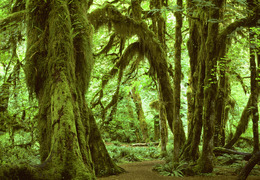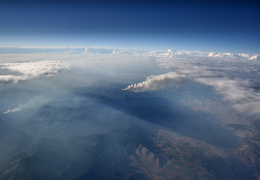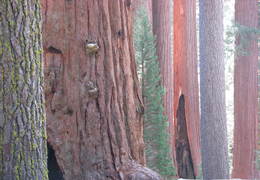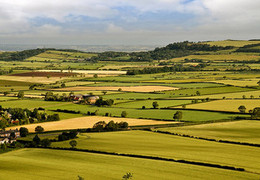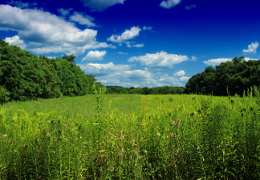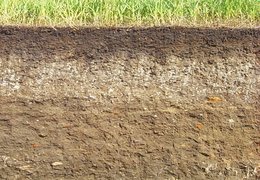Land Use and Land Cover
- /ecoregions/
Now Showing: 2006
Summary
Land-use and land-cover (LULC) data serve as input to both aquatic and terrestrial biogeochemical modeling frameworks for assessing carbon and greenhouse gas fluxes. Annual LULC maps were produced from 1992 to 2050. 1992 to 2005 serves as the "baseline" period, while 2006 to 2050 represents the "projected" period. The historical baseline period was designed to utilize LULC data based on remote sensing data to provide a realistic representation of historical LULC conditions from 1992 to 2005. The projected period uses future storylines from the Intergovernmental Panel on Climate Change (IPCC) Special Report on Emissions Scenarios (SRES) in conjunction with a spatial modeling method to produce LULC maps from 2006 to 2050.
LULC data are spatially and thematically consistent throughout the analysis period, with annual maps provided from 1992 to 2050. The spatial resolution of the data is 250 meters, allowing for adequate representation of landscape pattern while maintaining a reasonable data volume. The classification scheme is a mix of land-cover and land-use classes, selected to maximize our ability to analyze carbon and greenhouse gas fluxes. The thematic resolution of the LULC data is comparable to the National Land Cover Database (NLCD) and is more detailed than the five ecosystems analyzed in this assessment (forests, wetlands, croplands, grassland/shrublands, and aquatic). Increased numbers of LULC classes improves our ability to analyze carbon and greenhouse gas fluxes. The multiple urban/developed classes in NLCD were collapsed to one urban/developed class. Multiple classes representing forest cutting on different ownership types were added to improve our ability to model forestry activity.
Three scenarios based on IPCC SRES are provided for the 2006 to 2050 period. Multiple scenarios are used to help bound uncertainty associated with future driving forces of landscape change, and their resultant effects on land-use and land-cover.
Suggested Citation
Zhu, Zhiliang, ed., Bergamaschi, Brian, Bernknopf, Richard, Clow, David, Dye, Dennis, Faulkner, Stephen, Forney, William, Gleason, Robert, Hawbaker, Todd, Liu, Jinxun, Liu, Shuguang, Prisley, Stephen, Reed, Bradley, Reeves, Matthew, Rollins, Matthew, Sleeter, Benjamin, Sohl, Terry, Stackpoole, Sarah, Stehman, Stephen, Striegl, Robert, Wein, Anne, and Zhu, Zhiliang, 2010, A method for assessing carbon stocks, carbon sequestration, and greenhouse-gas fluxes in ecosystems of the United States under present conditions and future scenarios: U.S. Geological Survey Scientific Investigations Report 2010–5233, 188 p. (Available from USGS).
Methods
A hierarchical ecoregion framework based on U.S. Environmental Protection Agency (EPA) ecoregions was used as a spatial framework for partitioning the conterminous United States into meaningful ecological units. EPA level I ecoregions serve as the primary reporting unit for the overall assessment, but the much finer-scale level III ecoregions served as the base LULC mapping and modeling unit. Each of 84 level III ecoregions for the conterminous United States were individually parameterized and modeled. IPCC SRES storylines used to guide the LULC projections are general and global in nature, and needed to be downscaled to the ecoregion scale. The IPCC SERS scenarios were downscaled with a scenario downscaling accounting model, with projections from the Integrated Model to Assess the Global Environment (IMAGE), regional land-use histories, and expert knowledge used in a workshop setting to produce qualitative storylines and quantitative scenarios for each of the 84 Level III ecoregions in the conterminous United States. Quantitative proportions of the individual LULC classes were provided for each ecoregion in 5-year increments from 2006 to 2050.
The FOREcasting SCEnarios of land-use change (FORE-SCE) model was used to produce spatially explicit LULC maps based on regional scenario specifications. FORE-SCE is designed to take advantage of both historical and current LULC research and data from the USGS. The model uses a patch-based allocation procedure, with spatial characteristics of individual LULC patches based on historical land cover data. The location of new LULC patches is based on probability surfaces that quantify the suitability of a given location to support each LULC class. A Protected Area Database is used to spatially define protected lands such as National Parks, with individual types of protected lands shielded from specific types of LULC change, dependent upon scenario. FORE-SCE also tracks forest stand age as forests are clearcut or new forest areas are established, information that is used to mimic realistic forest cutting cycles in a given region. All data and input parameters are individually parameterized for each Level III ecoregion. FORE-SCE places of patches of LULC change on the landscape, one by one, until the scenario-prescribed proportions of future LULC are met for a given year. The result are spatially explicit, thematically detailed, annual LULC maps for each of the three IPCC SRES scenarios.
